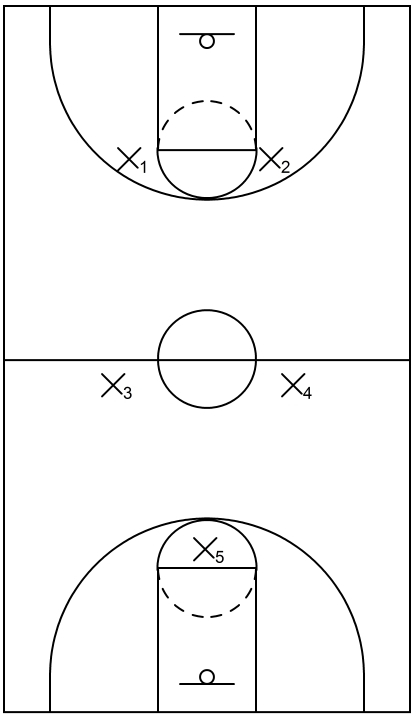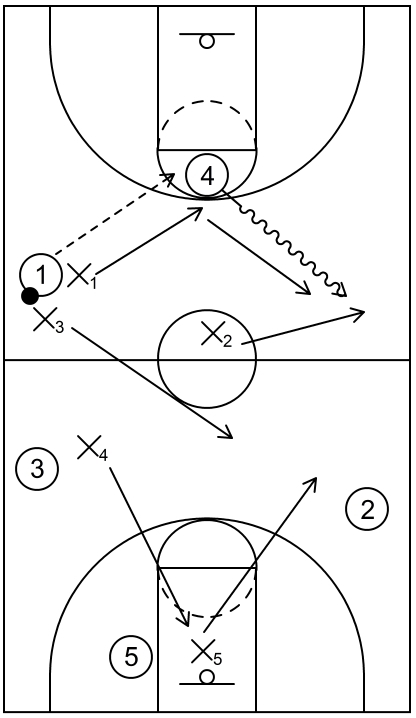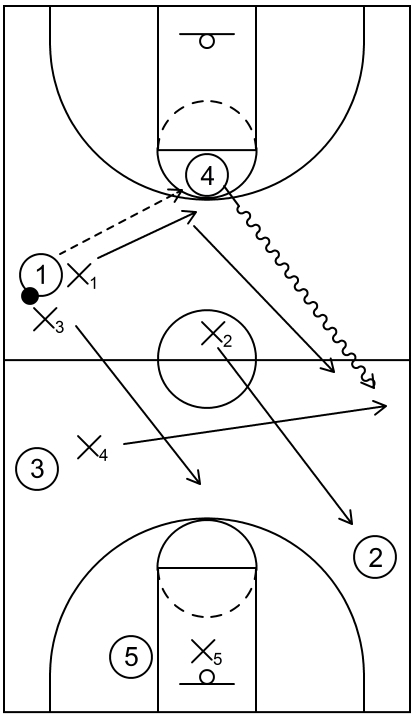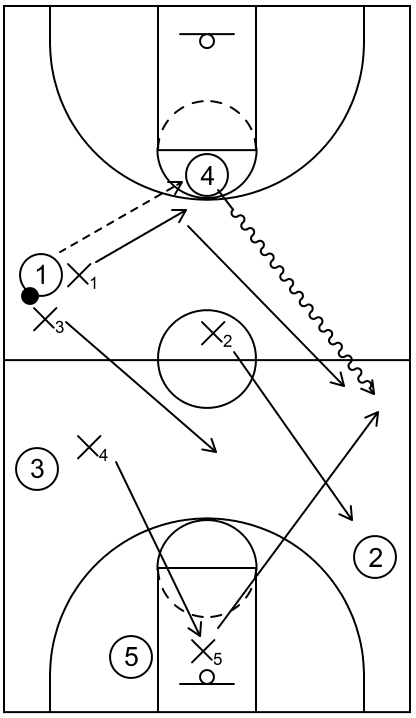What is the 2-2-1 press defense in basketball
The 2-2-1 press defense is a basketball defensive strategy that seeks to limit offensive scoring opportunities with the possibility of creating turnovers by way of sideline traps in the backcourt or frontcourt.
What is an example of the initial formation for the 2-2-1 press defense

This is an example of the initial formation for the 2-2-1 press defense. In the backcourt, X1 and X2 start near the high post elbows inside of the three-point arc. In the frontcourt, X3 and X4 start near the half court line within the extended slots.
Also, X5 starts near the high post area. However, it should be noted that X3 and X4 could also start near the half court line in the backcourt and additionally, X5 has the option to drop back into the lane if a player on offense cuts below the free throw line extended areas.
What are the general responsibilities of the defenders within the 2-2-1 press defense
The responsibilities of X1 and X2 are to influence the ball handler into dribbling towards a sideline, protect the middle area of the court, and set traps near the sidelines. Also, in some instances, X1 and X2 could cover the ball side wing areas in the frontcourt as well.
The responsibilities of X3 and X4 are to set sideline traps, cover the ball side wing areas in the frontcourt, protect the middle areas, and protect the basket in certain situations.
The responsibilities of X5 are to mainly protect the basket and occasionally, cover the ball side wing areas in the frontcourt or set traps near the sidelines.
What is an advantage of the 2-2-1 press defense
One particular advantage of the 2-2-1 press defense is that it can disrupt the flow of the offensive team and cause them to make uncharacteristic mistakes. For example, an offensive team may attempt to break the press, particularly in the backcourt, by executing multiple passes.
In theory, this seems to be a valid option. However, multiple passes combined with pressure defense could lead to turnovers because one or more of those passes may not be highly accurate.
As another example, a player with the ball might panic upon receiving the defensive pressure and then try to break the press by speed dribbling around the defenders. This will most likely be a recipe for disaster and it will probably result in a turnover.
What is a disadvantage of the 2-2-1 press defense
One notable disadvantage of the 2-2-1 press is that the defenders will typically cover quite a bit of area, particularly in the frontcourt. Therefore, the 2-2-1 press may not be as advantageous for defensive teams that do not possess an adequate amount of speed or quickness.
What are examples of the 2-2-1 press defense
Example 1

This is an example of the 2-2-1 press defense when 1 receives the ball from 4 and after that, X1 influences 1 to dribble towards the sideline. As that occurs, X3 steps across the half court line in preparation to set the primary trap with X1.
At the same time, X2 drops down to protect the middle of the court while X4 cuts across to the ball side wing area in the frontcourt.
Additionally, X5 could drop back to protect the basket because there is at least one offensive player below the free throw line extended area in the frontcourt.
Example 2

This is an example of the 2-2-1 press defense when X1 and X3 set the primary trap in the backcourt. However, 3 is able to receive the ball from 1 and when that occurs, X3 sprints across the half court line to set a trap near the sideline with X4.
At the same time, X1 sprints down towards the high post area in the frontcourt while X2 sprints down to cover the middle area in the frontcourt. X5 continues to protect the basket.
Example 3

This is an example of the 2-2-1 press defense when 1 executes a backwards pass to relieve pressure from the trap so 4 receives the ball near the high post area in the backcourt.
When that happens, X1 quickly sprints back up to influence 4 to dribble towards the opposite sideline.
At the same time, X2 sprints towards 4 in preparation to set the sideline trap with X1. While that occurs, X3 drops down to protect the middle area in the frontcourt, X4 sprints across the court to cover the ball side wing area, and X5 continues to protect the basket.
Example 4

This is another example of what could possibly transpire after the backcourt backwards pass within the 2-2-1 press defense. For this case, X1 and X2 set a trap in the backcourt while X3 covers the middle area as before.
However, this time, X5 sprints up to cover the ball side wing area in the frontcourt while X4 drops back to protect the basket. This particular example could be considered if X5 has a considerable amount of speed and quickness.
Essentially, it would appear that 2 is open to receive the ball but as 4 executes that potential pass, 5 could step into the passing lane and intercept the ball, which causes a turnover.
Example 5

This is yet another example of backcourt backwards pass action within the 2-2-1 press defense. This time, the trap occurs in the frontcourt as opposed to the backcourt.
Basically, after 4 receives the ball, X1 influences 4 to dribble the ball all the way into the frontcourt.
It is at that moment when X4 could set a surprise trap with X1 because 4 most likely would not see X4 cutting across the court to set that trap.
Also, as that happens, X2 covers the ball side wing area, X3 covers the middle area, and X5 continues to protect the basket.
Example 6

This is another example of what could happen with the backwards pass in the backcourt for the 2-2-1 press defense. Once again, the trap occurs in the frontcourt. After 4 receives the ball, X1 influences 4 to dribble the basketball into the frontcourt.
Similar to the previous diagram, it is at that moment when X5 could set a surprise trap with X1 because 4 would probably not see X5 sprinting up the court to set that trap.
Additionally, X2 covers the ball side wing area, X3 covers the middle, and X4 drops back to protect the basket.
What are comparable defensive strategies in relation to the 2-2-1 press defense
The 1-1-3 press defense is a full court press that implements ball pressure in the backcourt and defensive traps in the frontcourt.
The 1-2-1-1 press defense is a full court press that could be utilized by teams with speed, quickness and very good conditioning with the main purpose of creating turnovers via traps set in the backcourt.
The 1-2-2 press defense features a variety of traps in the backcourt as well as the frontcourt, which could then lead to limited offensive scoring opportunities or potential turnovers.
The 1-3-1 press defense consists of backcourt ball pressure and frontcourt traps near the sidelines with the objective of limiting offensive scoring options.
The 2-1-2 press defense implements defensive traps near the sidelines to disrupt the scoring effectiveness of the offensive team with the additional possibility of creating turnovers.
The havoc press is a variation of the 1-2-1-1 press and it was popularized by Coach Shaka Smart, particularly during his time as the head coach of the VCU Rams men’s basketball team.